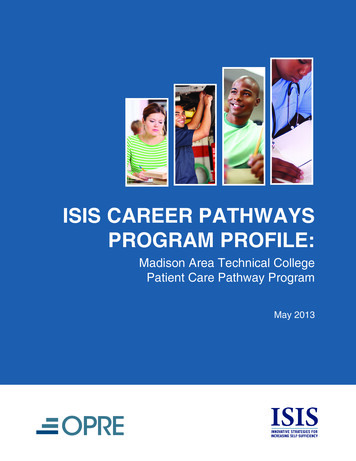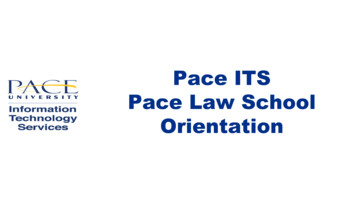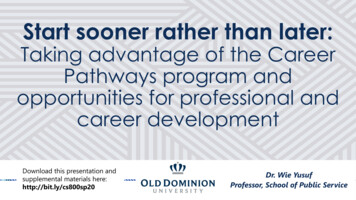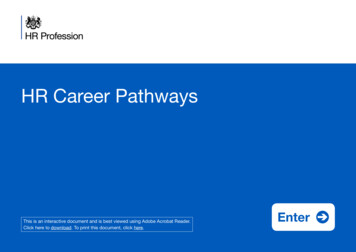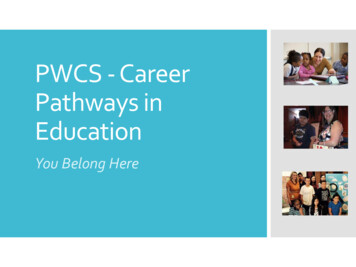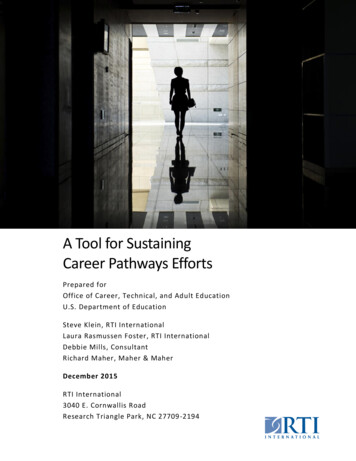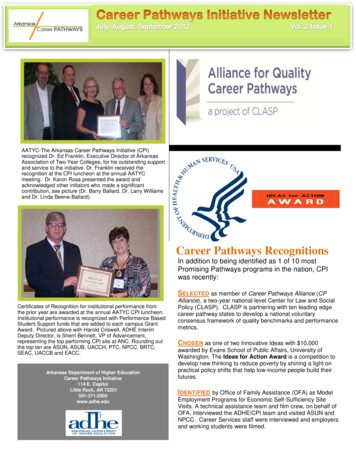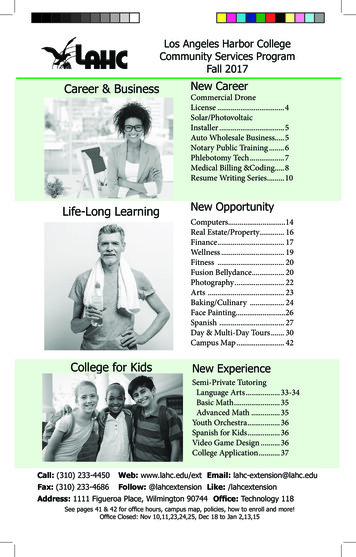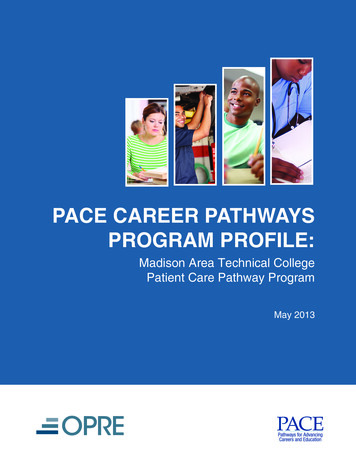
Transcription
February 2013PACE CAREER PATHWAYSPROGRAM PROFILE:Madison Area Technical CollegePatient Care Pathway ProgramMay 20131
This report is in the public domain. Permission to reproduce is not necessary. Suggested citation: Cook,Rachel, Gardiner, Karen and Karin Martinson. (2013). Pathways for Advancing Careers and Education CareerPathways Program Profile: Madison Area Technical College Patient Care Pathway Program. OPRE Report #2013-20, Washington, DC: Office of Planning, Research and Evaluation, Administration for Children andFamilies, U.S. Department of Health and Human Services.Submitted to:Brendan Kelly, Project OfficerOffice of Planning, Research and EvaluationAdministration for Children and FamiliesU.S. Department of Health and Human ServicesContract Number: HHSP23320072913YCProject Director:Karen GardinerAbt Associates, Inc.4550 Montgomery Ave.Bethesda, MD 20814Disclaimer: The views expressed in this publication do not necessarily reflect the views or policies of the Officeof Planning, Research and Evaluation, the Administration for Children and Families, or the U.S. Departmentof Health and Human Services.This report and other reports sponsored by the Office of Planning, Research and Evaluation are available .
F e b r uMaar y 2 0 1 3IntroductionThere is a substantial skills gap betweenthe education and training of the laborforce and the needs of employers inmany high growth industries, includinghealthcare and manufacturing. This gapresults in unemployment while goodpaying jobs go unfilled. At the same time,many low-skilled adults persist in lowwage work with little opportunity foradvancement.1 Career pathways programsare an approach to fill a vital need forskilled workers in the economy and offerlow-wage workers the opportunity toobtain occupational and other skills andadvance into the middle class.The goal of career pathways programs is toimprove the education and earnings of lowskilled adults by providing well-articulatedtraining and employment steps, combinedwith promising instructional approachesand supportive services, which are targetedto jobs that are in demand locally. There isgreat interest in career pathways programsamong policy makers and practitionersin part because such programs provide aframework for guiding the developmentof improved education and trainingapproaches for low-skilled individuals.Along these lines, the Pathways forAdvancing Careers and Education (PACE)study is using an experimental designto assess the effectiveness of nine careerpathway programs across the country.An experimental evaluation design assigns individuals eligible for a program via lottery to a treatmentgroup that can receive the program or a control group that cannot -- but can access other services in thecommunity. Because the assignment process is random, there are no systematic differences between thetreatment and control groups at the time they enter the study. Thus, any differences detected during thefollow-up period can be attributed to the program. Random assignment is considered the gold standard ofprogram evaluation.31
24Career Pathways Program Profile:Madison Area Technical College Patient Care Pathway ProgramThis profile is an overview of the Madison AreaTechnical College (MATC) Patient Care PathwayProgram (PCPP).2 Designed and operated by MATCin Madison, Wisconsin, PCPP targets students whootherwise would not be able to pursue a post-secondarydegree in the health field because of their low skilllevels. It is designed to accelerate entry into college-levelhealthcare programs by allowing students to pursuebasic skills and occupational training simultaneously.The program also provides supports and advising.This profile first describes the career pathwayframework used in the PACE evaluation, aframework that provides a common approach fordescribing and assessing career pathways programs,and then discusses MATC’s PCPP model and how itfits within the career pathway framework.3The Career PathwaysFrameworkThe career pathways thesis is that post-secondaryeducation and training should be organized as a seriesof manageable steps leading to successively highercredentials and employment opportunities in growingoccupations. Each step is designed to prepare studentsfor the next level of employment and education andalso provide a credential with labor market value.To effectively engage, retain, and facilitate learning,programs integrate four core elements: (1) assessment,(2) promising instructional strategies, (3) supports, and(4) employer connections. Individual programs varyin terms of emphasis placed on each core component,although all are comprehensive in nature in order toaddress the learning and life challenges facing adultstudents. Mobilizing these components typicallyrequires a partnership between multiple providers,including community-based organizations, communityand technical colleges, human services and workforceagencies, and employers and their representatives.Although steps in career pathways programs varywith their target populations, focal occupations,and service strategies, the broad training andemployment levels shown in Figure 1 provide a basisfor classifying programs.Prospects for good-paying, stable employmentFigure 1: The Career Pathways StepsV. BA Programs Upper-Skilled JobsIV. 1-2 year Certificate to AA Programs Mid-Level Skilled JobsIII. Short-Term Certificate Programs Entry Level Skilled JobsII. Sectoral Bridge Programs Semi-Skilled JobsI. Basic Bridge ProgramsOccupational, academic, and life skills
F e b r uMaar y 2 0 1 3The first two steps (I and II) represent “onramp” programs designed to prepare lowskilled participants for college-level trainingand lower-skilled jobs with a career focus.The next two steps (III and IV) providecollege-level training for “middle skills”employment—jobs requiring some collegebut less than a bachelor’s degree (e.g., anassociate’s degree or shorter certificate).The final step (V) includes interventionspromoting completion of a bachelor’s degreeand more advanced credentials. Careerpathways are designed to allow entries, exits,and re-entries at each stage—depending onskill levels and prior training, employmentprospects, and changing personal situations.Programs vary in terms of entry and exitpoints as well as steps incorporated.MATC’s Patient CarePathway ProgramPCPP targets low-skilled adult learnersand includes key components of thecareer pathways model. It featuresaccelerated entry into college-leveldegree or diploma programs in healthfor those with skill levels too low to meetentry requirements. The instruction iscontextualized, allowing students tobuild knowledge about the healthcare fieldwhile simultaneously increasing their basicskills. Additionally, the program providesa range of support services to encouragestudents to complete classes, addressissues they may face, and plan for futureacademic, occupational, and employmentopportunities.Program Goals, Target Populationand StructurePCPP is operated by the MATC School ofOnline and Accelerated Learning, whichis responsible for a range of occupationaltrainings for returning adults. MATCdeveloped PCPP to promote enrollmentin and accelerate completion of collegelevel healthcare programs for lower-skilledstudents. Many students cannot entertheir chosen one- or two-year healthcareprogram each year due to low basic skills.Of those students, 75 percent nevercomplete the necessary remediation toraise their skills and thus do not enroll ina health program. This is likely becauseremediation can add up to three semestersof school work. PCPP was designed toimprove persistence and completionamong low-skilled students.PCPP targets students who are interestedin a healthcare career but score too lowon the COMPASS test to enroll inMATC’s six one-year health diplomaprograms (Medical Coding, AdvancedMedical Coding, Massage Therapy, MedicalAssistant, Optometric Technician, andLicensed Practical Nurse) or eight twoyear health degree programs (AssociateDegree Nursing, Dental Hygiene, MedicalLab Technician, Occupational TherapyAssistant, Physical Therapy Assistant,Radiography, Respiratory Therapy, and theone-year Surgical Technician Diploma).4 Inthe absence of the program, students wouldfirst have to raise their skill levels, potentiallythrough basic education courses. They thenwould move to the course prerequisites35
4Career Pathways Program Profile:Madison Area Technical College Patient Care Pathway Programneeded for enrollment, a sequence that may takeseveral semesters. In comparison, PCPP provides basiceducation in parallel with field-specific courseworkwithin one semester.PCPP students generally are at an 8th-10th gradelevel equivalent in their reading or math skills.Although a high school diploma or GED is notrequired for program entry, most students have asecondary credential since one is required for entryinto college programs. The program does not havean income eligibility requirement, but staff reportthat the majority of students are low income.Within the PACE career pathways model, PCPP isdesigned so that individuals enter a sectoral bridgeprogram (step II in Figure 1) and then move to oneor two-year diploma or degree programs (step IV).PCPP provides two tracks: Patient Care Academies 1and 2. Where a student starts depends on his or herinterests (diploma or degree) and skill level (as assessedby the COMPASS ). Figure 2 depicts the PCPPacademies and associated pathways, including the sixdiploma and eight degree programs available. TheFigure 2. PCPP Course Content and Career PathwayTarget Population: Individuals interested in health careers who have placement test scores too low to begin in theprograms in the traditional manner. Students interested in a one-year Health Diploma program would take PCA 1. Studentsinterested in a Health Associates Degree program (or the one-year Surgical Technician diploma) can start with either PCA 1 orPCA-2 depending on their placement test scores.EducationPatient Care 2 (1 semester)ChemistryApplied Math forChemistryPatient Care 1 (1 semester)Written Communicationsfor HealthcareBody Structure & FunctionMedical TerminologySupport Classes: Math,Reading, and Student SuccessEmployment1-Year Health DiplomaPrograms Medical CodingAdvanced medical CodingMassage TherapyMedical AssistantOptometric TechnicianLicensed Practical NurseMid-Level EmploymentGraduates report wages rangingfrom 12.72 to 16.85 per hour,depending on job and programchoice. Titles vary based onprogram choice.2-Year Health AssociatesDegrees Associate Degree NursingDental HygieneMedical Lab TechnicianOccupational TherapyAssistantPhysical Therapy AssistantRadiographyRespiratory TherapySurgical Technician (1-yearDiploma)Upper-Mid-Level EmploymentGraduates report wages rangingfrom 17.82 to 24.17 per hour,depending on job and programchoice. Titles vary based onprogram choice.
May 2013specific program components are describedin the next section. Briefly: Patient Care Academy 1 (PCA 1)is designed for students interestedin a one-year health diploma whoseCOMPASS scores are too low toenter directly into the program ofchoice. As well, students interested ina two-year degree program but whodo not have the requisite skills toenter PCA 2 start at PCA 1. Duringthe one-semester academy, studentscomplete a series of non-credit adultbasic skills classes and two for-credithealth courses needed for the diplomaprograms. After completing PCA 1,students can move into a one-yearhealth diploma program, if they meetthe program admission-requiredCOMPASS test scores, or they canmove into PCA 2 which will preparethem to pursue a two-year degreeprogram.5Patient Care Academy 2 (PCA 2)is designed for students interested inpursuing a two-year health Associate’sDegree or the one-year SurgicalTechnician program and whoseCOMPASS scores are too low toenter these programs but high enoughto test out of PCA 1. While the SurgicalTechnician program is a one-yeardiploma, it is most appropriate for thosewho complete PCA 2 because Chemistryis a prerequisite for the program. Overthe course of the semester, students enrollconcurrently in Math and Chemistry(rather than taking them sequentiallyas is typically required) and also takeWritten Communications for Healthcare,a course requirement for all of MATC’stwo-year health programs. Studentsreceive credits for the Chemistry andWritten Communications courses. Aftercompleting PCA 2, students have fulfilledneeded prerequisites for the two-yeardiploma programs in one semester. PCA2 completers do not need to retake theCOMPASS ; they are directly eligible fortheir degree programs.Although students do not receive acertificate or credential at the conclusionof the academies, they are able to movemore quickly into the health diplomaand degree programs. Each PCA course isstaffed by its respective department—theDepartment of Arts and Sciences operatesWritten Communications and Chemistry,the Adult Basic Education departmentoperates the basic skills courses, and theHealth Department provides occupationalskills courses. Staff at the School of Onlineand Accelerated Learning coordinatethe program and provide the advisingcomponent. The Admissions departmentis a key partner for assisting studentsin enrolling in college programs aftercompleting PCA 1 or PCA 2. Programrecruitment is supported by MATC’s testingdepartment as well as the local WorkforceInvestment Board and other local partners.PCPP builds on existing MATC programsin the manufacturing, informationtechnology, business technology andhealthcare fields. It aims to improvestudents’ academic and occupational skillsand prepare them to transition to collegeand earn a post-secondary credential.5
6Career Pathways Program Profile:Madison Area Technical College Patient Care Pathway ProgramUltimately, PCPP strives to help students obtaindiplomas and degrees so they can secure a good jobor advance to a higher level in the healthcare fieldand improve their overall economic, personal andfamily well-being.the first advising session, staff and students discuss thereported barriers and potential solutions, includingreferrals to other service providers as needed.Career Pathway ComponentsBoth Patient Care Academies include credit-basedhealthcare-related courses and non-credit basic skillscourses. PCA 1 and PCA 2 classes are scheduledconsecutively on two (PCA 1) or three (PCA 2) dayseach week to accommodate working students.6Career pathways programs draw from a widerepertoire of services strategies to address theacademic and non-academic needs of participants.PCPP incorporates promising approaches toacademic and non-academic assessment, basic skillsinstruction and occupational training, and studentsupports. PCPP also involves employers in programdesign. Each approach is described below.AssessmentPCPP uses the COMPASS test to assess students’academic skills and determine program placement.COMPASS is an untimed, computer-basedassessment used to gauge academic skill level inmath, reading, writing, and English as a SecondLanguage (ESL). Some instructors also use the testscores to help gauge initial student skill level andadjust lessons accordingly.PCPP also administers a non-academic barriersassessment at the beginning of each academy. Staffcreated the barriers assessment, which asks studentsto report: Long-term academic and career goals;Current employment status and schedule;Financial aid status and needs;Other coursework being taken;Non-academic barriers such as lack of childcare,difficulty paying bills, lack of housing, etc.; andCriminal background.PCPP advisors use the non-academic assessmentresults in their discussions with students. Starting inCurriculumThe curriculum of PCA 1 includes: Two health diploma prerequisite courses – Medi cal Terminology and Body Structure and Func tion – which provide students with an introduc tion to fundamentals in health; One Lab course that provides unstructured timefor the health instructor to answer questions orreview material;Two classes focused on contextualized basic skillsin reading and math – Academic Reading Surveyand Math Survey; andOne course – Student Success Survey – thatprovides structured instruction in a range ofnon-academic topics including study skills, timemanagement, computer skills, financial advising,and strategies for navigating college. All courses are delivered over a 16-week period. Theprogram is designed so that basic skills courses arecontextualized for the health field and emphasize “collegesuccess” strategies, such as helping students work on timemanagement, goal setting, study skills, and computerskills. While the basic skills and content courses areseparate classes, students take all of the courses together asa cohort and instructors work collaboratively to developthe curriculum and communicate about student progressthroughout the semester.As shown in Figure 3, the PCA 1 courses are staggered
F e b r uMaar y 2 0 1 3Figure 3: Schedule of PCA 1 CoursesStudent Success SurveyAcademic Reading SurveyMath SurveyBody Structure and FunctionStudent Success LabMedical Terminology12345678910111213141516Weeks in PCA 1 Semesterthroughout the semester so that at anytime students are enrolled in no more thanfour courses. For the first two weeks of theacademy, students take only the Reading,Student Success, and Math basic skills classes.In the third week of the semester, the BodyStructure and Function course begins. Afterfive weeks, the Reading and Student Successclasses end and the Medical Terminologycourse and Student Success Lab begin.Students spend about 12.5 hours in classeach week, with the exception of the first twoweeks when they are in class approximately6.5 hours per week.Over the course of the semester, studentscomplete a total of 64 hours in MathSurvey, 12 hours in Academic Reading,24 hours in Student Success Survey, 56hours in Body Structure and Function,55 hours in Medical Terminology, and 22hours in the Student Success Lab. Uponcompletion, PCA 1 students will haveearned 6 credits towards a health diploma,which require between 19 and 33 credits.PCA 2 includes three courses completedover a 16-week period: Chemistry – a prerequisite for all twoyear health degree programs – providescollege-level Chemistry instructionutilizing, when possible, examples andactivities from the health field;Applied Math for Chemistry supportsthe PCA 2 Chemistry course and wasdeveloped jointly by the adult basicskills and chemistry faculty; andWritten Communication forHealthcare is a degree requirementfor all health programs and iscontextualized for the health field.Unlike the traditional course route,which requires students to take Math andChemistry sequentially, PCA 2 studentstake Applied Math and Chemistryconcurrently, thus accelerating theircompletion of prerequisites and entryinto degree programs. The instructorscollaborate so that the courses are alignedand, like PCA 1, students take all of theclasses together as a group. While thePCA 1 classes are staggered throughoutthe semester, each of the PCA 2 coursesruns for the full semester, as shown inFigure 4. PCA 2 students are in classes97
8Career Pathways Program Profile:Madison Area Technical College Patient Care Pathway ProgramFigure 4: Schedule of PCA 2 CoursesGeneral ChemistryApplied Math for ChemistryWritten Communication for Healthcare1234567891011Weeks in PCA 2 Semesterfor 12 hours each week for the 16 week semester.Over the course of the semester, students spend80 hours in Chemistry, 72 hours in AppliedMath for Chemistry, and 40 hours in WrittenCommunication for Healthcare. Upon completion,students earn 7 credits: 4 for Chemistry and 3 forWritten Communications. PCA 2 completion meetsthe admissions requirements for most College healthprograms, which require between 60 and 70 credits.SupportsPCPP provides a number of supports to students inPCA
MATC’s six one-year health diploma programs (Medical Coding, Advanced Medical Coding, Massage Therapy, Medical Assistant, Optometric Technician, and Licensed Practical Nurse) or eight two-year health degree programs (Associate Degree Nursing, Dental Hygiene, Medical Lab Technician, Occupational Therapy Assista
